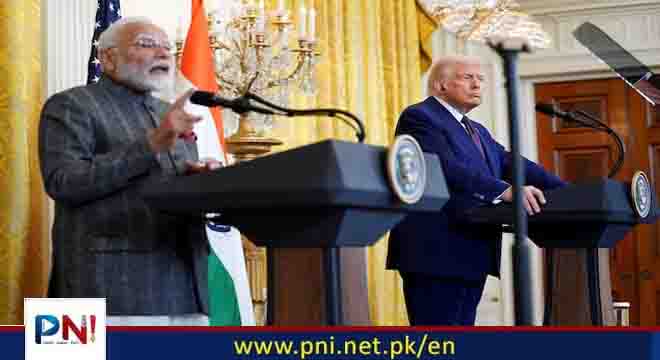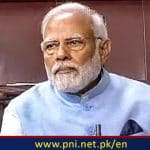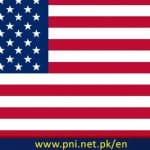WASHINGTON, Feb 15 : The United States will boost military sales to India starting in 2025 and will eventually provide super-sophisticated F-35 fighter jets, President Donald Trump has said.
“We’ll be increasing military sales to India by many billions of dollars. We’re also paving the way to ultimately provide India with the F-35 stealth fighters,” Trump told a news conference after a meeting with Indian Prime Minister Narendra Modi at the White House.
Modi became the fourth world leader to visit Trump since the start of his second term as US president.
Trump did not provide a timeline, but foreign military sales, especially for cutting-edge technology like the stealthy F-35 jet, typically take years to work through, US officials said.
Commenting on New Delhi-Washington relations, Drop Site, an American news outlet, wrote,”The close ties between the Indian government of Narendra Modi, the Trump administration, and tech oligarch Elon Musk have been on stark display during the prime minister’s two-day state visit to the United States.
“What the three of them share, alongside a not-so-subtle contempt for democratic norms, are economic interests that have drawn them into ever-closer collaboration—particularly as the U.S. seeks allies to help contain China in the decades to come.
“Washington’s embrace of India has come as it transforms into a more brash, nationalistic society under Modi. Two years ago, this transformation began making itself directly felt in the West, after India was publicly accused of carrying out surveillance, intimidation, and even targeted assassinations in Canada and the U.S., including the killings of at least two men. As the story below shows, this campaign has by no means ceased,” Drop Site added.
While the two leaders met, hundreds of protestors , including Kashmiris and Sikhs, massed outside the White House’s entrances, decrying Modi for targeting minorities and abusing their rights.
As anti-Modi slogans went up, digital advertising trucks, sponsored by the World Kashmir Awareness Forum (WKAF), flashed messages for Kashmir’s freedom as they drove around the White House, the Capitol Hill, and across other federal buildings and foreign embassies.
The electronic screens on the mobile digital trucks carried messages such as: “Fascist Modi Does Not Belong to White House”; “Modi found Guilty of Crimes Against Humanity in Gujrat”; “Modi on a Killing Spree: Occupied Kashmir Needs to be Free”; “Modi Guilty of Crimes Against Humanity in Kashmir”; Indian Forces in Kashmir Commit Brutality: Modi Responsible for Bestiality”; “India Stop Land Grabbing in Kashmir”; “Indian Army Out of Kashmir”, and “Modi Commits Crime Against Humanity: World Community Needs to Bring Sanity.“
Dr. Ghulam Nabi Fai, Chairman of the World Forum for Peace & Justice, reminded Trump that Modi’s visa was revoked by the US State Department in 2005 after he was found guilty of crimes against humanity in Guajrat.
Now, he said Kashmir was at the brink of genocide, while the news media in the UN-recognized disputed territory was at the brink of extinction, as reported by Dr. Gregory Stanton, Chairman Genocide Watch and the New York-based Committee to Protect Journalists” (CPJ), respectively.
D. Fai also reminded the Trump administration of what the internationally known Indian novelist and human rights activist, Arundhati Roy wrote: “Kashmir is the largest militarized zone in the world.”
Dozens of Sikhs waved flags for the Khalistan movement or held placards such as one urging Trump to “cut Modi down to size.”
Many said they were uncomfortable speaking to a reporter because of their fears of reprisal, citing the assassination attempts against Sikh separatists. “We like President Trump. We don’t like Prime Minister Modi because he’s against Sikh rights,” said one protester, who gave his name as Mr. Singh. “We don’t like to share [our] first names, because he just comes for any country … and kills so many Sikh people.”
Meanwhile, a much smaller group of pro-Modi demonstrators stood on the opposite side, holding signs that read “America Welcomes Narendra Modi.” The demonstrators said they supported efforts to crack down on illegal immigration from India, but criticized the overly harsh treatment of some recent deportees.
Addressing the news conference with Prime Minister Modi, Trump also said the countries had struck an agreement that includes India importing more U.S. oil and gas to shrink the trade deficit between the two countries.
Indian Foreign Secretary Vikram Misri told reporters later that New Delhi follows an elaborate process for foreign military purchases including seeking proposals from manufacturers and evaluating them.
“I don’t think with regard to the acquisition of an advanced aviation platform by India, that process has started as yet,” he said when asked about the F-35 announcement by Trump. “This is currently something that’s at the stage of a proposal.”
Foreign military sales like those of the F-35 are considered government-to-government deals where the Pentagon acts as an intermediary between the defense contractor and a foreign government.
India has agreed to buy more than $20 billion of U.S. defence products since 2008. Last year, India agreed to buy 31 MQ-9B SeaGuardian and SkyGuardian drones after deliberations that lasted more than six years.
According to the U.S. Congressional Research Service, New Delhi is expected to spend more than $200 billion over the next decade to modernize its military.
Lockheed is producing three models of the new warplanes for the U.S. military and allies including Britain, Australia, Italy, Turkey, Norway, the Netherlands, Israel, Japan, South Korea and Belgium.
Russia has for decades been the main weapons supplier to India, the world’s biggest arms importer, and its fighter jets are part of India’s military fleet. But Moscow’s ability in recent years to export has been hobbled by the war in Ukraine, making New Delhi look westward.
Russia has offered to make its fifth-generation stealth fighter jet Sukhoi Su-57 in India for the Indian Air Force, a Russian and an Indian official said on Tuesday, as Moscow looks to maintain strong ties with New Delhi.
The Washington Post said, “The partnership is a pillar of Washington’s strategy in the Indo-Pacific region, but one that is beset with trouble spots on illegal immigration, visas, America’s large trade deficit with India and controversies over India’s attempted assassination of a Sikh activist on American soil.”
During the news conference, Trump sought to emphasize the friendship between Washington and New Delhi, even as he announced shortly before it that the United States would implement a “reciprocal” tariff policy that would tax foreign goods at the same rate that other nations apply to American products, potentially complicating talks with India.
On the issue of immigration — which sparked outrage in India after the Trump administration sent deportees back to the country in shackles on military fights — Modi said New Delhi will comply with Trump’s desires. “We are of the opinion that anybody who enters another country illegally, they have absolutely no right to be in that country,” Modi said.
In one of the few moments the Indian prime minister spoke English, Modi became the latest leader trying to foster a personal relationship with Trump. The Indian leader borrowed from Trump’s “Make America Great Again” rhetoric to announce his own vision: Make India Great Again, or MIGA, he said in English, adding that the two countries could continue to help each other.
“When it’s MAGA plus MIGA, it becomes ‘mega’ — a mega-partnership for prosperity,” the Indian prime minister said, according to a translator.
The United States is India’s largest trading partner, buying more than 18 percent of all its exports. America is running a $45 billion trade deficit with India, and Trump is keen to shrink it. The lack of parity, as well as lingering frustration from a trade deal that never materialized during his first term, drove Trump to describe India on the campaign trail last year as a “very big abuser” of tariffs.
In a call with Modi last month — the second such conversation between the two leaders since the American election — Trump stressed the “importance of India increasing its procurement of American-made security equipment and moving toward a fair bilateral trading relationship,” according to a White House readout.
Modi visited Washington armed with concessions aimed at averting a trade war and staving off damaging tariffs on the world’s fifth-largest economy. The concessions include a commitment to significantly boost purchases of American energy. New Delhi has already reduced tariffs on high-end American motorcycles — a fixation for Trump, who repeatedly called the 100 percent duty on Harley-Davidsons “unacceptable.”
India signaled it was open to offering tariff concessions for imports from the United States in several sectors, including electronics, medical equipment and chemicals, an analyst familiar with the matter said. The Modi administration is looking at potential deals on U.S. agriculture exports and nuclear energy investments, the analyst added, speaking on the condition of anonymity to discuss sensitive matters. Reuters earlier reported the possible concessions.
Ahead of his meeting with Trump, Modi on Thursday met with the president’s national security adviser, Michael Waltz. He also held meetings with billionaire Elon Musk and Vivek Ramaswamy, according to Indian officials. On Wednesday, he held talks with Trump’s director of national intelligence, Tulsi Gabbard.
Follow the PNI Facebook page for the latest news and updates.








